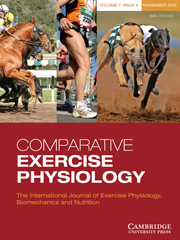Article contents
Pre-competitive arousal, perception of equine temperament and riding performance: do they interact?
Published online by Cambridge University Press: 11 June 2010
Abstract
There is a known relationship between the way athletes interpret the feelings of pre-competitive arousal and their subsequent performance. In equestrian sports, riders' interpretation of their horses' temperament may be an additional unique factor that influences the levels of riders' arousal and performance. The aims of this study were to investigate the effect of intensity and direction of arousal and self-confidence on dressage and showjumping performance, and to investigate how perception of equine temperament traits affects arousal and performance components. Twenty-two student riders (6 males and 16 females) competing on unfamiliar horses were asked to participate in the study. Prior to the competition, riders completed the Revised Competitive Sport Anxiety Inventory-2 with direction scales, and rated their horses' temperament traits using an adapted Five Factor Personality Questionnaire. Dressage performance scores were found to be positively correlated with cognitive arousal intensity (r = − 0.5, P < 0.05) and self-confidence intensity (r = 0.59, P < 0.05). Showjumping faults were negatively correlated with somatic arousal direction scores (r = − 0.5, P < 0.05). The ‘active’ equine temperament was positively correlated with somatic arousal intensity in showjumping (r = 0.5, P < 0.05) and negatively correlated with cognitive arousal direction in dressage (r = − 0.71, P < 0.005). These findings suggest that riders' self-confidence and perception of their horses' temperament are important factors in the relationship between arousal and performance.
Keywords
- Type
- Research Paper
- Information
- Copyright
- Copyright © Cambridge University Press 2010
References
- 13
- Cited by


